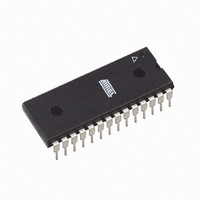ATMEGA8-16PC Atmel, ATMEGA8-16PC Datasheet - Page 130

ATMEGA8-16PC
Manufacturer Part Number
ATMEGA8-16PC
Description
IC AVR MCU 8K 16MHZ COM 28-DIP
Manufacturer
Atmel
Series
AVR® ATmegar
Specifications of ATMEGA8-16PC
Core Processor
AVR
Core Size
8-Bit
Speed
16MHz
Connectivity
I²C, SPI, UART/USART
Peripherals
Brown-out Detect/Reset, POR, PWM, WDT
Number Of I /o
23
Program Memory Size
8KB (4K x 16)
Program Memory Type
FLASH
Eeprom Size
512 x 8
Ram Size
1K x 8
Voltage - Supply (vcc/vdd)
4.5 V ~ 5.5 V
Data Converters
A/D 6x10b
Oscillator Type
Internal
Operating Temperature
0°C ~ 70°C
Package / Case
28-DIP (0.300", 7.62mm)
Lead Free Status / RoHS Status
Contains lead / RoHS non-compliant
Other names
ATMEGA816PC
- Current page: 130 of 302
- Download datasheet (6Mb)
AVR USART vs. AVR
UART – Compatibility
Clock Generation
130
ATmega8(L)
The dashed boxes in the block diagram separate the three main parts of the USART (listed from
the top): Clock generator, Transmitter and Receiver. Control Registers are shared by all units.
The clock generation logic consists of synchronization logic for external clock input used by syn-
chronous slave operation, and the baud rate generator. The XCK (transfer clock) pin is only
used by synchronous transfer mode. The Transmitter consists of a single write buffer, a serial
Shift Register, Parity Generator and control logic for handling different serial frame formats. The
write buffer allows a continuous transfer of data without any delay between frames. The
Receiver is the most complex part of the USART module due to its clock and data recovery
units. The recovery units are used for asynchronous data reception. In addition to the recovery
units, the Receiver includes a parity checker, control logic, a Shift Register and a two level
receive buffer (UDR). The Receiver supports the same frame formats as the Transmitter, and
can detect Frame Error, Data OverRun and Parity Errors.
The USART is fully compatible with the AVR UART regarding:
•
•
•
•
•
However, the receive buffering has two improvements that will affect the compatibility in some
special cases:
•
•
The following control bits have changed name, but have same functionality and register location:
•
•
The clock generation logic generates the base clock for the Transmitter and Receiver. The
USART supports four modes of clock operation: normal asynchronous, double speed asynchro-
nous, Master synchronous and Slave Synchronous mode. The UMSEL bit in USART Control
and Status Register C (UCSRC) selects between asynchronous and synchronous operation.
Double speed (Asynchronous mode only) is controlled by the U2X found in the UCSRA Regis-
ter. When using Synchronous mode (UMSEL = 1), the Data Direction Register for the XCK pin
(DDR_XCK) controls whether the clock source is internal (Master mode) or external (Slave
mode). The XCK pin is only active when using Synchronous mode.
Figure 62 on page 131
Bit locations inside all USART Registers
Baud Rate Generation
Transmitter Operation
Transmit Buffer Functionality
Receiver Operation
A second Buffer Register has been added. The two Buffer Registers operate as a circular
FIFO buffer. Therefore the UDR must only be read once for each incoming data! More
important is the fact that the Error Flags (FE and DOR) and the ninth data bit (RXB8) are
buffered with the data in the receive buffer. Therefore the status bits must always be read
before the UDR Register is read. Otherwise the error status will be lost since the buffer state
is lost
The Receiver Shift Register can now act as a third buffer level. This is done by allowing the
received data to remain in the serial Shift Register (see
Registers are full, until a new start bit is detected. The USART is therefore more resistant to
Data OverRun (DOR) error conditions
CHR9 is changed to UCSZ2
OR is changed to DOR
shows a block diagram of the clock generation logic.
Figure 61 on page
129) if the Buffer
2486Z–AVR–02/11
Related parts for ATMEGA8-16PC
Image
Part Number
Description
Manufacturer
Datasheet
Request
R

Part Number:
Description:
IC AVR MCU 8K 16MHZ 5V 32TQFP
Manufacturer:
Atmel
Datasheet:

Part Number:
Description:
IC AVR MCU 8K 16MHZ 5V 32-QFN
Manufacturer:
Atmel
Datasheet:

Part Number:
Description:
IC AVR MCU 8K 16MHZ 5V 28DIP
Manufacturer:
Atmel
Datasheet:

Part Number:
Description:
IC AVR MCU 8K 16MHZ COM 32-TQFP
Manufacturer:
Atmel
Datasheet:

Part Number:
Description:
IC AVR MCU 8K 16MHZ IND 32-TQFP
Manufacturer:
Atmel
Datasheet:

Part Number:
Description:
IC AVR MCU 8K 16MHZ IND 28-DIP
Manufacturer:
Atmel
Datasheet:

Part Number:
Description:
IC AVR MCU 8K 16MHZ COM 32-QFN
Manufacturer:
Atmel
Datasheet:

Part Number:
Description:
MCU AVR 8KB FLASH 16MHZ 32QFN
Manufacturer:
Atmel
Datasheet:

Part Number:
Description:
IC AVR MCU 8K 16MHZ IND 32-QFN
Manufacturer:
Atmel
Datasheet:

Part Number:
Description:
IC MCU AVR 8K 5V 16MHZ 32-TQFP
Manufacturer:
Atmel
Datasheet:

Part Number:
Description:
IC MCU AVR 8K 5V 16MHZ 32-QFN
Manufacturer:
Atmel
Datasheet:

Part Number:
Description:
IC MCU AVR 8K 5V 16MHZ 28-DIP
Manufacturer:
Atmel
Datasheet:

Part Number:
Description:
IC MCU AVR 8K 16MHZ 5V 32TQFP
Manufacturer:
Atmel
Datasheet:











